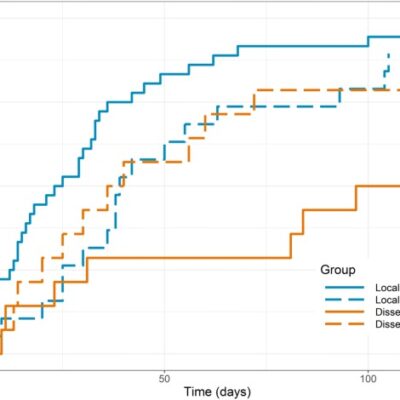Valerio Iacovelli, Chiara Cipriani, Marco Sandri, Roberta Filippone, Antonella Ferracci, Salvatore Micali, Bernardo Rocco, Stefano Puliatti, Paolo Ferrarese, Giuseppe Benedetto, Andrea Minervini, Andrea Cocci, Antonio Luigi Pastore, Yazan Al Salhi, Alessandro Antonelli, Tonino Morena, Alessandro Volpe, Filippo Poletti, Antonio Celia, Guglielmo Zeccolini, Costantino Leonardo, Flavia Proietti, Enrico Finazzi Agrò, Pierluigi Bove
- PMID: 32236663
- PMCID: PMC7223519
- DOI: 10.1007/s00345-020-03170-7
Abstract
Purpose: To explore the role of vacuum assisted closure (VAC) therapy versus conventional dressings in the Fournier’s gangrene wound therapy.
Patients and methods: This is a retrospective multi-institutional cohort study. Data of 92 patients from nine centers between 2007 and 2018 were retrospectively analyzed. After surgery, patient having a local or a disseminated FG were managed with VAC therapy or with conventional dressings. The 10-weeks wound closure cumulative rate and OS were analyzed.
Results: Of the 92 patients, 62 (67.4%) showed local and 30 (32.6%) a disseminated FG. After surgery, 19 patients (20.7%) with local and 14 (15.2%) with disseminated FG underwent to VAC therapy; 43 (46.7%) with local and 16 (17.4%) with disseminated FG were treated using conventional dressings. The multivariable logistic regression analysis demonstrated that the VAC in patients with disseminated FG led to a higher cumulative rate of wound closure than patients treated with no-VAC (OR = 6.5; 95% CI 1.1-37.4, p = 0.036). The Kaplan-Meier survival curves for the OS showed a significant difference between no-VAC patients with local and disseminated FG (OS rate at 90 days 0.90, 95% CI 0.71-0.97 vs 0.55, 95% CI 0.24-0.78, respectively; p = 0.039). Cox regression confirmed that no-VAC patients with disseminated FG showed the lowest OS (hazard ratio adjusted for sex and age HR = 3.4, 95% CI 1.1-10.4; p = 0.033).
Conclusions: In this large cohort study, VAC therapy in patients with disseminated FG may offer an advantage in terms of 10-weeks wound closure cumulative rate and OS at 90 days after initial surgery.
Keywords: Fournier’s gangrene; Necrotizing fasciitis; Overall survival; VAC; Vacuum-assisted closure therapy; Wound therapy.
Conflict of interest statement
The authors declare that they have no conflict of interest.



